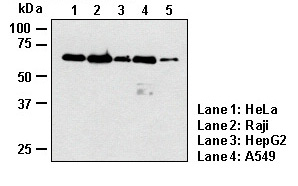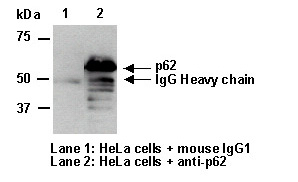| Code No. |
M162-3 |
|
Anti-p62 (SQSTM1) (Human) mAb
|
| 価格(税別) |
¥52,800
|
| 包装 |
100 µL (1 mg/mL) |
| 在庫 |
10以上
(2024/04/25 00:05時点)
|
| クローナリティー |
Monoclonal |
| クローン |
5F2 |
アイソタイプ
(免疫動物) |
Mouse IgG1 κ |
| 使用法 |
WB 1 µg/mL
IP 2 µg/250 µL of cell extract from 2.5x106 cells
FCM 2 µg/mL
IC 5 µg/mL
IH 2-10 µg/mL (Heat treatment is necessary for paraffin embedded sections.)
|
| 免疫原(抗原) |
Recombinant Human p62 (120-440 a.a.) |
| 交差性
[Gene ID] |
Human[8878], Mouse(-), Rat(-), Hamster(-) |
| 性状 |
1 mg/mL in PBS/50% glycerol, pH 7.2 |
| 保存温度 |
-20°C |
| 標識 |
Unlabeled |
| メーカー |
MBL |
| 別称 |
sequestosome 1, p60, p62, A170, OSIL, PDB3, ZIP3, p62B |
| 背景 |
p62/SQSTM1 interacts with various molecular groups such as RIP, TRAF6, ERK, aPKCs, and poly-ubiquitin through PB1 domain, Zn finger domain, and UBA domain. This protein directly interacts with LC3, which is localized on autophagosome membrane, and is degradated by autophagic-lysosome pathway. p62 regulates ubiquitin-positive protein aggregates caused by autophagy deficiency. |
| 関連製品 |
PM045 Anti-p62 (SQSTM1) pAb
M162-A48 Anti-p62 (SQSTM1) (Human) mAb-Alexa Fluor™ 488
M162-A59 Anti-p62 (SQSTM1) (Human) mAb-Alexa Fluor™ 594
M162-A64 Anti-p62 (SQSTM1) (Human) mAb-Alexa Fluor™ 647
PM066 Anti-p62 C-terminal pAb
PM036 Anti-LC3 pAb
M152-3 Anti-LC3 mAb
M186-3 Anti-LC3 mAb
PD014 Anti-LC3 pAb
PM069 Anti-NRF2 pAb
PM072 Anti-VMP1 pAb
8485 Autophagy Ab Sampler Set
PM090 Anti-Atg8 (Filamentous fungi) pAb
D343-3 Anti-Phospho-p62 (SQSTM1) (Ser403) mAb
D344-3 Anti-Phospho-p62 (SQSTM1) (Ser403) mAb
PM074 Anti-Phospho-p62 (SQSTM1) (Ser351) pAb
M224-3 Anti-KEAP1 mAb
M200-3 Anti-NRF2 mAb
D343-3MS Anti-Phospho-p62 (SQSTM1) (Ser403) mAb for My select sampler set
D344-3MS Anti-Phospho-p62 (SQSTM1) (Ser403) mAb for My select sampler set
M152-3MS Anti-LC3 mAb for My select sampler set
PM074MS Anti-Phospho-p62 (SQSTM1) (Ser351) pAb for My select sampler set
M230-3 Anti-Parkin mAb
PM037 Anti-GABARAP pAb
8486 Autophagy Watch
M135-3 Anti-GABARAP mAb
M217-3 Anti-Phospho-p62 (SQSTM1) (Ser351) mAb
M217-3MS Anti-Phospho-p62 (SQSTM1) (Ser351) mAb for My select sampler set
PM038 Anti-GATE-16 pAb
MK-12-3 Anti-Ubiquitin mAb
CY-7055 CycLex® Total p62 ELISA Kit
|
| 製品カテゴリー |
分野:オートファジー |
| データ |





|
| 使用文献 |
Western Blotting - Soll C et al. Serotonin promotes tumor growth in human hepatocellular cancer. Hepatology 51, 1244-54 (2010)(PMID:20099302)
- Fan W et al. Keap1 facilitates p62-mediated ubiquitin aggregate clearance via autophagy. Autophagy 6, 614-21 (2010)(PMID:20495340)
- Wang BS et al. Autophagy negatively regulates cancer cell proliferation via selectively targeting VPRBP. Clin Sci (Lond). 124, 203-14 (2013)(PMID:22963397)
- Rovetta F et al. ER signaling regulation drives the switch between autophagy and apoptosis in NRK-52E cells exposed to cisplatin. Exp Cell Res. 318, 238-50 (2012)(PMID:22146761)
- Matsumoto G et al. Serine 403 phosphorylation of p62/SQSTM1 regulates selective autophagic clearance of ubiquitinated proteins. Mol Cell. 44, 279-89 (2011)(PMID:22017874)
- Schmeisser H et al. Type I interferons induce autophagy in certain human cancer cell lines. Autophagy 9, 683-96 (2013)(PMID:23419269)
- Guo X et al. Patulin induces pro-survival functions via autophagy inhibition and p62 accumulation. Cell Death Dis. 4, e822 (2013)(PMID:24091665)
- Zhu X et al. Cytosolic HMGB1 controls the cellular autophagy/apoptosis checkpoint during inflammation. J Clin Invest. 125, 1098-110 (2015)(PMID:25642769)
- Janda E et al. Parkinsonian toxin-induced oxidative stress inhibits basal autophagy in astrocytes via NQO2/quinone oxidoreductase 2: Implications for neuroprotection. Autophagy 11, 1063-80 (2015)(PMID:26046590)
- Stolz A et al. Fluorescence-based ATG8 sensors monitor localization and function of LC3/GABARAP proteins. EMBO J. 36, 549-564 (2017)(PMID:28028054)
- Sakamoto S et al. Mild MPP+ exposure-induced glucose starvation enhances autophagosome synthesis and impairs its degradation. Sci Rep. 7, 46668 (2017)(PMID:28443637)
- Wacker R et al. Fluorescence-based ATG8 sensors monitor localization and function of LC3/GABARAP proteins. Cell Microbiol. 19, e12754 (2017)(PMID:28573684)
- Bingel C et al. Three-dimensional tumor cell growth stimulates autophagic flux and recapitulates chemotherapy resistance. Cell Death Dis. 8, e3013 (2017)(PMID:28837150)
- Schmuckli-Maurer J et al. Inverted recruitment of autophagy proteins to the Plasmodium berghei parasitophorous vacuole membrane. PLoS One. 12, e0183797 (2017)(PMID:28841718)
- Lötzerich M et al. Rhinovirus 3C protease suppresses apoptosis and triggers caspase-independent cell death. Cell Death Dis. 9, 272 (2018)(PMID:29449668)
- Sun Y et al. 3′-epi-12β-hydroxyfroside, a new cardenolide, induces cytoprotective autophagy via blocking the Hsp90/Akt/mTOR axis in lung cancer cells. Theranostics 8, 2044-2060 (2018)(PMID:29556372)
- Kanda R et al. Expression of the glucagon-like peptide-1 receptor and its role in regulating autophagy in endometrial cancer. BMC Cancer 18, 657 (2018)(PMID:29907137)
- Qiu J et al. Distinct subgroup of the Ras family member 3 (DIRAS3) expression impairs metastasis and induces autophagy of gastric cancer cells in mice. J Cancer Res Clin Oncol. 144, 1869-1886 (2018)(PMID:30043279)
- Mori H et al. Induction of selective autophagy in cells replicating hepatitis C virus genome. J Gen Virol. 99, 1643-1657 (2018)(PMID:30311874)
- Nakashima A et al. Endoplasmic reticulum stress disrupts lysosomal homeostasis and induces blockade of autophagic flux in human trophoblasts. Sci Rep. 9, 11466 (2019)(PMID:31391477)
- Ishii S et al. Identification of a factor controlling lysosomal homeostasis using a novel lysosomal trafficking probe. Sci Rep. 9, 11635 (2019)(PMID:31406198)
- Li S et al. CACNA1H downregulation induces skeletal muscle atrophy involving endoplasmic reticulum stress activation and autophagy flux blockade. Cell Death Dis. 11, 279 (2020)(PMID:32332705)
- Yamamuro T et al. Age-dependent loss of adipose Rubicon promotes metabolic disorders via excess autophagy. Nat Commun. 11, 4150 (2020)
(PMID:32811819)
Immunoprecipitation - Wang BS et al. Autophagy negatively regulates cancer cell proliferation via selectively targeting VPRBP. Clin Sci (Lond). 124, 203-14 (2013)(PMID:22963397)
Immunocytochemistry - Akaishi R et al. Autophagy in the placenta of women with hypertensive disorders in pregnancy. Placenta 35, 974-80 (2014)(PMID:25465707)
- Janda E et al. Parkinsonian toxin-induced oxidative stress inhibits basal autophagy in astrocytes via NQO2/quinone oxidoreductase 2: Implications for neuroprotection. Autophagy 11, 1063-80 (2015)(PMID:26046590)
- Schmuckli-Maurer J et al. Inverted recruitment of autophagy proteins to the Plasmodium berghei parasitophorous vacuole membrane. PLoS One. 12, e0183797 (2017)(PMID:28841718)
- Zhao Q et al. Dual Roles of Two Isoforms of Autophagy-related Gene ATG10 in HCV-Subgenomic replicon Mediated Autophagy Flux and Innate Immunity. Sci Rep. 7, 11250 (2017)(PMID:28900156)
- Doerflinger SY et al. Membrane alterations induced by nonstructural proteins of human norovirus. PLoS Pathog. 13, e1006705 (2017)(PMID:29077760)
- Nakashima A et al. Endoplasmic reticulum stress disrupts lysosomal homeostasis and induces blockade of autophagic flux in human trophoblasts. Sci Rep. 9, 11466 (2019)(PMID:31391477)
Immunohistochemistry - Wang BS et al. Autophagy negatively regulates cancer cell proliferation via selectively targeting VPRBP. Clin Sci (Lond). 124, 203-14 (2013)(PMID:22963397)
- Park JM et al. Prognostic impact of Beclin 1, p62/sequestosome 1 and LC3 protein expression in colon carcinomas from patients receiving 5-fluorouracil as adjuvant chemotherapy. Cancer Biol Ther. 14, 100-7 (2013)(PMID:23192274)
- Onodera Y et al. NRF2 immunolocalization in human breast cancer patients as a prognostic factor. Endocr Relat Cancer. 21, 241-52 (2014)
- Akaishi R et al. Autophagy in the placenta of women with hypertensive disorders in pregnancy. Placenta 35, 974-80 (2014)(PMID:25465707)
- Ishii S et al. Identification of a factor controlling lysosomal homeostasis using a novel lysosomal trafficking probe. Sci Rep. 9, 11635 (2019)(PMID:31406198)
|





 Copyright (C)2015 Medical & Biological Laboratories Co., Ltd. All Rights Reserve
Copyright (C)2015 Medical & Biological Laboratories Co., Ltd. All Rights Reserve